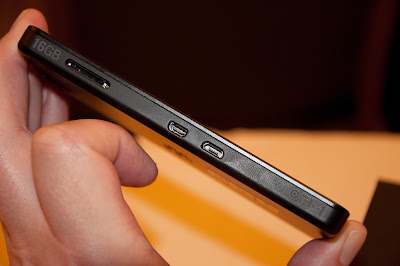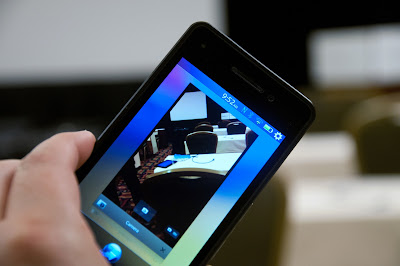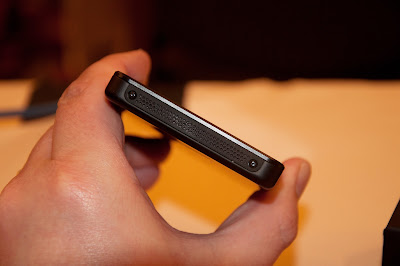BlackBerry Dev Alpha: First Take

If you're about to reboot a platform, you really need developers on-board and ready before it's released to the general public. That doesn't mean giving developers access to an SDK and simulators — it means getting real code, and real devices, into their hands. It's why Microsoft handed out a Samsung tablet running Windows 8 to developers at its BUILD conference, and why developers at RIM's BlackBerry Jam event in Orlando are getting a first look at BlackBerry 10, in the shape of the BlackBerry Dev Alpha.
We sat down with RIM's Tim Neil for a first look at the Dev Alpha. Like any modern smartphone it's a large, thin device. RIM isn't giving too much detail on its specifications, apart from telling us that it sports a 4.2in. screen with a resolution of 1024 by 768 pixels. Perhaps best thought of as a shrunken PlayBook, the Dev Alpha has all the ports and many of the features of its larger sibling, including HDMI and Micro-USB connections. The buttons are similar, and in very similar positions, although the microSIM drawer shows that this is definitely a phone.
 \
A Dev Alpha, along with its manuals
\
A Dev Alpha, along with its manuals
Held in the hand, the device feels very much like the PlayBook, as it's coated in the same rubber-like finish. It's a very different tactile experience from any other smartphone, and one we hope RIM continues to use on production BlackBerry 10 devices. There's something rugged about the Dev Alpha as a result of that finish, making it a phone that both looks good and feels tough. One of the more unusual features of the Dev Alpha is a barcode printed under the screen. It's present on all devices, and is used as a device identifier.
 Front view, with the 4.2in. screen.
Front view, with the 4.2in. screen.
 Side view, with media controls and camera and flash
Side view, with media controls and camera and flash
 Side view with microSIM slot, HDMI and Micro-USB ports
Side view with microSIM slot, HDMI and Micro-USB ports
 Top view with microphone and headphone jack
Top view with microphone and headphone jack
Developers who get the device will be getting a blank slate, which Neil describes as "very much stripped down". The only software included is a browser and a camera application (there are two cameras on the Dev Alpha, one front-facing and a higher-resolution rear camera with flash). There's no messaging application, and no marketplace — it's clearly a device for testing applications and for trying out RIM's new Cascades user experience. Under the hood there's a lot of progress, with full multi-processor support as well as storage and the underpinings for the QT-based Cascades.
 The Dev Alpha's camera in action
The Dev Alpha's camera in action
If the screen is any mark of a phone, the Dev Alpha's crisp and clean display is one of the best we've seen. With much of the UI currently ported across from the PlayBook, the Dev Alpha needs that screen — there's no font scaling and some of the text in the Dev Alpha's settings app is very small indeed. At least with Dev Alpha's display it remains clear and legible, even when just a few pixels high.
 The Dev Alpha's extremely clear display
The Dev Alpha's extremely clear display
The device we looked at didn't have a SIM — the microSIM tray wasn't present — so we weren't able to use it as a phone. Wi-Fi performance was good, web pages loading and rendering quickly, with both Flash and HTML5 content shown. There's also support for NFC, including the ability to use it with the device off — allowing exchange of credentials and basic e-commerce.
 The Dev Alpha's browser works well, rendering the desktop view of sites like ZDNet UK
The Dev Alpha's browser works well, rendering the desktop view of sites like ZDNet UK
If the Dev Alpha says any one thing about BlackBerry 10, it's that RIM thinks the time is right for developers to get access to real code on real devices. The fact that it's also an interesting design isn't that important — what's crucial for RIM, and for BlackBerry 10, are the applications it inspires and that use it as a test platform. Certainly, when combined with the tools in the new BlackBerry 10 SDKs, the Dev Alpha now gives RIM the tools it needs to manage a complex developer transition, from Java to C++ and QT.
Simon Bisson

